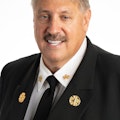Have you ever wondered how far we have come with EMS delivery since 1966, when the National Academy of Science white paper Accidental Death and Disability: The Neglected Disease of Modern Society was released? If you compare the state of emergency medicine in 1966 to what we have today, you will see that we have come quite far.
A 60-year-old man who collapsed in cardiac arrest on a street in 1966 probably died. Why? First, there was no 911 system. Someone would have had to run to a landline telephone to call for help. Unless they had memorized the seven-digit number of the local ambulance service or it was on a sticker pasted to the telephone, a person summoning help would have to look up the number in the front of a telephone book. Once the call was made, the only help sent was an ambulance and maybe a police officer. In some cities, the police would transport patients to a hospital in vehicles normally used for transporting prisoners. Some ambulances were operated by funeral homes.
Once emergency personnel arrived, there was no guarantee any of them were medically trained. If they were medically trained, probably the most training they had was first-aid or advanced first-aid. The equipment in the ambulance or police vehicle was for the most part limited to a stretcher and an oxygen bottle.
Since the man who collapsed was in cardiac arrest and CPR was not that widely known or used in 1966, other resuscitation techniques might have been used by the emergency personnel, including mouth-to-mouth resuscitation or back-thrust maneuvers. It's more likely that the responders placed an oxygen mask on the man's face, put him on a stretcher and raced him to the closest hospital, regardless of its capabilities, since there were no trauma centers. There were probably some attempts made at resuscitation in the emergency room, but this man almost had a 100% chance of dying, since he went without oxygen too long and the system was not designed to save a person's life.
Imagine if the same man collapsed on a street today. Someone, will have immediately called 911 from a cell phone. If it is a progressive community, there may be an automated external defibrillator (AED) close and some bystander may know CPR.
While the caller was on the phone with the 911 center receiving pre-arrival instructions, medically trained first responders from the nearest fire station would be dispatched. Chances are the fire company has a firefighter/paramedic with advanced life support (ALS) equipment on board. At a minimum, there are probably EMTs on the fire company who can perform advanced procedures. In most cases, the fire company would arrive within four to six minutes. At the same time the fire company was being dispatched, an ambulance is also being sent to the scene. Again, chances are the ambulance has ALS equipment and paramedics on board.
Emergency personnel would use the latest equipment and techniques in an attempt to stabilize the cardiac arrest victim. This includes intubation, IVs, intraosseous infusion, defibrillation, mechanical CPR devices and drug therapy. In some communities, all this information is sent through a telemedicine system to a Level 1 trauma center, where physicians read the patient's vital signs and EKG.
After the patient's pulse and blood pressure have been restored and stabilized, the paramedic can induce hypothermia therapy to cool the patient prior to arrival at the hospital. The paramedic also can transmit a 12-lead EKG to the hospital, where a determination can be made that the victim has a fresh myocardial infarction (MI) and will need the cardiac catheterization lab to open the closed artery. The patient's EKG is transmitted to the cardiac cath team and they assemble to await the arrival of the ambulance.
At the scene, the victim is loaded onto a power stretcher and into the back of the ambulance. The ambulance carries an automatic ventilator and the paramedic sets the respiratory and tidal volume rates. The victim is transported to the hospital with the cardiac cath lab and the crew does not stop at the emergency room with the patient, but rather heads directly to the cath lab. Shortly thereafter, the hospital team has the artery in the patient's heart open.
It's amazing to contrast the two different periods and see the different outcomes. I'm glad I'm here to see it.
GARY LUDWIG, MS, EMT-P, a Firehouse® contributing editor, is a deputy fire chief with the Memphis, TN, Fire Department. He is chair of the EMS Section for the International Association of Fire Chiefs (IAFC), was appointed to the National EMS Advisory Council by the U.S. Secretary of Transportation and is a member of the International Association of Fire Fighters (IAFF) EMS Standing Committee. Ludwig has a master's degree in business and management and is a licensed paramedic. He can be reached at www.garyludwig.com.
About the Author
Gary Ludwig
GARY LUDWIG has served in three fire departments over his career: St. Louis, Memphis, and Champaign, IL. His fire, EMS and rescue career spanned a total of 46 years, and he has been a paramedic for over 44 years. Ludwig served as president of the International Association of Fire Chiefs in 2019-20. He has a Master’s degree in Business and Management, has written over 500 articles for professional fire and EMS publications and is the author of seven books.
Connect with Gary
Email: [email protected]
Facebook: Gary Ludwig
Twitter: @ChiefGaryLudwig
Website: garyludwig.com
